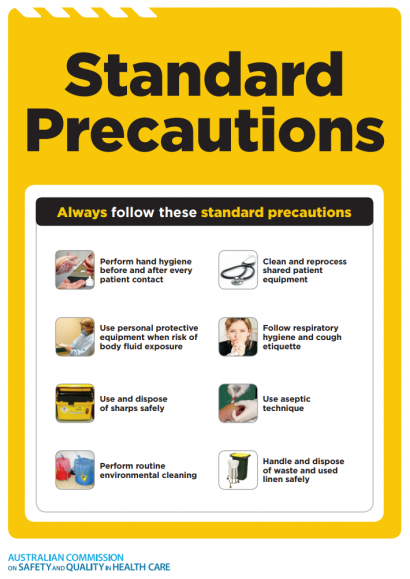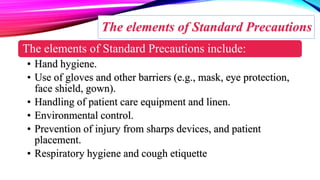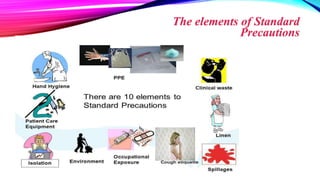Standard Precautions Should Be Used in Which of These Situations
Standard Precautions apply to 1 blood 2 all body fluid secretions and excretions except sweat 3 nonintact skin and 4 mucous membranes. Standard Precautions are the minimum infection prevention practices that apply to all patient care regardless of suspected or confirmed infection status of the patient in any setting where health care is delivered.

Cdc Standard Precautions Posters Infection Control Infection Control Nursing Hand Hygiene Posters
This Policy reflects the Standard infection control precautions.

. Start studying Standard Precautions. Standard Precautions are infection prevention practices used to avoid the transmission of infectious agents Standard Precautions are used with any patient regardless of known or suspected infection status. Wear a surgical mask and goggles or face shield if there is a reasonable chance that a splash or spray of blood or body fluids may occur to the eyes mouth or nose.
Standard precautions are protective interventions that are applied to. Gown and gloves eye protection and mask or respirator. STANDARD PRECAUTIONS are basic infection control guidelines for you to follow as you perform your daily work.
Center for Disease Control CDC recommends standard precautions SP to reduce the risk that HCWs face of acquiring HIV in their work place Beekmann Henderson 2005. Arent available use an alcohol-based hand sanitizer. Used for certain types of infectious organisms with some residents.
Blood All other body fluids except sweateven if you dont see blood Broken skin Mucous membranes like the inside of the eyelids nose or mouth Dried blood and body fluids Standard Precautions include. Standard precautions are meant to reduce the risk of transmission of bloodborne and other pathogens from both recognized and unrecognized sources. Infected so by applying standard infection control precautions to all people at all times best practice becomes second nature and the risk of infection are minimised.
Sweat is the only exception. Remove PPE immediately after use and wash hands. Hand hygiene before and after all patient contact.
Standard Precautions are designed to reduce the risk of transmission or microorganisms from both recognized and unrecognized sources of infection. Which circumstance is a patient care situation in which gloves are needed. Standard precautions consist of the following practices.
Blood including dried blood all other body fluidssubstances except sweat regardless of whether they contain visible blood. For environmental health exposures the use of standard precautions refers to general contact control practices that prevent contamination of the skin eyes mucous membranes and clothing. Standard precautions are meant to reduce the risk of transmission of bloodborne and other pathogens from both recognized and unrecognized sources.
While the principles need to be applied correctly the midwife needs to be alert to these situations. Wear a gown if skin or clothing is likely to be exposed to blood or body fluids. They are the basic level of infection control precautions which are to be used as a minimum in the care of all patients.
The basic premise of standard precautions is to treat all patientsresidents blood or body fluid as if they are infectious. Nonetheless in Chile there is little information. Airborne Droplet and Contact Precautions.
Standard precautions are ways of doing your work to lower the. It is important for the health care team member to understand that standard precautions should be used for every patient. PPE is selected based on the nature of patient interaction and anticipated exposure to blood or bodily fluids.
These precautions are organized into three groups. Precautions should be observed and appropriate protection used when caring for bleeding injuries. Respiratory hygiene and cough etiquette.
Touching blood body fluids or mucous membranes. When splashing of blood or body fluids is likely wear the following depending on the situation. Successful infection prevention and control involves routinely using basic infection prevention and control strategies such as hand hygiene.
Standard precautions should be used when there is or expected to be contact with blood vaginal and seminal secretions urine or faeces amniotic fluid cerebrospinal fluid saliva breast milk or any other bodily fluid. National hand hygiene and personal protective equipment policy published by NHS England and NHS Improvement March 2019. These precautions should be observed when contact with potentially hazardous materials body fluids fecal material and other environmental contaminants is a.
These alcohol-based products can quickly reduce the number of germs on hands in some situations but they are not a substitute for washing. Standard Precautions include Hand hygiene. The United Nations Joint Programme on HIVAIDS UNAIDS suggests that HCW are key actors in stopping spread of HIV UNAIDS 2000 2002.
Handling infectious waste material properly. These practices are designed to both protect DHCP and prevent DHCP from spreading infections among patients. Standard precautions are a group of infection prevention practices which include hand hygiene and the use of gloves gowns masks eye protection or face shields depending on the anticipated exposure.
Learn vocabulary terms and more with flashcards games and other study tools. They are the basic level of infection control precautions which are to be used as a minimum in the care of all patients. And safe handling and disposal of sharps waste and linen to minimise infection risk standard precautions in addition to.
You should use Standard Precautions with every cli-ent and when you have contact with. Standard Precautions Basic precautions to be used at all times with all clients to prevent transmission of bloodborne diseases. Use Standard Precautions and infection control techniques in all situations that may present the hazard of infection.
Using protective equipment like gloves gowns and masks. Standard precautions must be used in the handling of. Hand hygiene is a major component of standard.
Hand hygiene is a major component of standard. Wear gloves when you might touch blood or body fluids. In all of these situations gowns goggles and face masks should be used appropriately to prevent.
The purpose of using standard and transmission-based precautions is to reduce the transmission of infectious organisms to residents visitors and staff. Standard Precautions are written and regulated by OSHA the Occupational. Effectiveness of Standard Precautions depends.

Pin On Alliant International University

Cdc Standard Precautions Posters Infection Control Nursing Infection Control Cdc

Mega 20 Watt Solar Panel Blackdefault Title In 2022 Solar Panels Monocrystalline Solar Panels Off Grid Solar Panels
![]()
Standard And Transmission Based Precautions And Signage Australian Commission On Safety And Quality In Health Care

4 Essential Ways To Keep Your Workplace Safe Infographic Health And Safety Poster Safety Infographic Infographic Health
![]()
Standard And Transmission Based Precautions And Signage Australian Commission On Safety And Quality In Health Care

Standard And Transmission Based Precautions And Signage Australian Commission On Safety And Quality In Health Care

Construction Safety Matters No More Accidents At Work Slip And Fall Construction Safety Risk Management

Dpr7 Droplet Precautions Sign Brevis Com Fundamentals Of Nursing Nurse Nursing Process

Break The Chain Of Infection Infection Prevention And You Chain Of Infection Infection Control Nursing Infection Control

Infection Prevention And Control Physiopedia

Creating The Ideal Burning Environment Burn Right Products Burns Environment Optimization

Carpentry Safety Precautions Visual Ly Safety Precautions Occupational Safety Occupational Health And Safety

Medical Conditions That Require Contact Precautions Nursing Notes Medical Nursing Assessment





Comments
Post a Comment